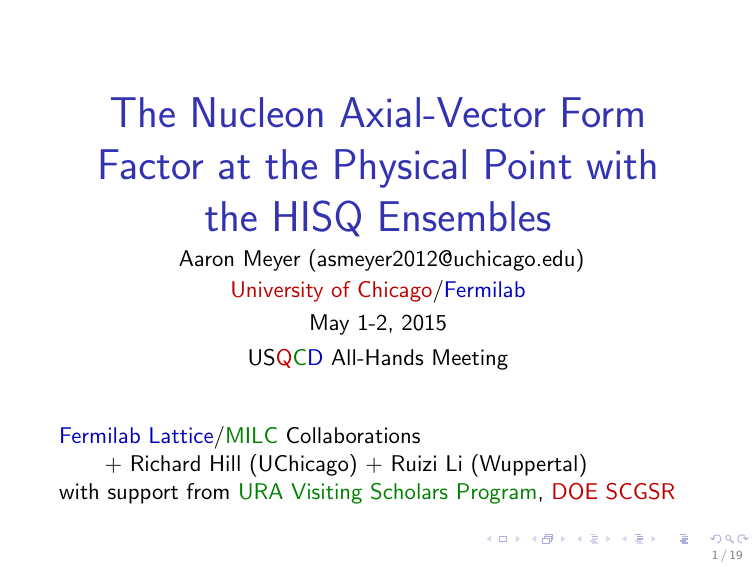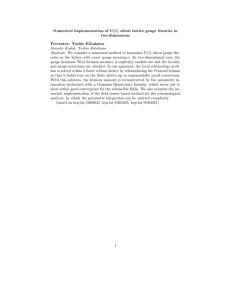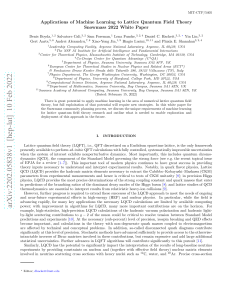The Nucleon Axial-Vector Form Factor at the Physical
advertisement

The Nucleon Axial-Vector Form Factor at the Physical Point with the HISQ Ensembles Aaron Meyer (asmeyer2012@uchicago.edu) University of Chicago/Fermilab May 1-2, 2015 USQCD All-Hands Meeting Fermilab Lattice/MILC Collaborations + Richard Hill (UChicago) + Ruizi Li (Wuppertal) with support from URA Visiting Scholars Program, DOE SCGSR 1 / 19 Calculation Overview We will use MILC HISQ 2+1+1 ensembles at Mπ = 135 MeV with 3 lattice spacings Our primary objectives are to calculate: • gA , FA (q 2 ) → Neutrino CCQE/Oscillation Studies • gV , FV (q 2 ) → Validation Check/Proton Radius Puzzle As a byproduct, we will also get: • FP (q 2 ) → ντ interaction cross section • gS → Dark matter searches and µ to e conversion • gT → New physics in neutron β decay 2 / 19 Motivation Neutrino physics needs a better understanding of axial form factor: • Model-dependent shape parameterization introduces systematic uncertainties and underestimates errors • Nuclear effects entangled with nucleon cross sections • Measurement of oscillation parameters depends on nuclear models and nucleon form factors 3 / 19 Circle of Uncertainty Nucleon-level/Nucleus-level effects entangled Measurements of observables are model-dependent LQCD acts as disruptive techology to break the cycle 4 / 19 Discrepancies in the Axial-Vector Form Factor Most analyses assume the “Dipole form factor”: 1 FAdipole (q 2 ) = gA 2 2 1 − mq 2 (1) A Dipole is an ansatz: unmotivated in interesting energy range → uncontrolled systematics and underestimated uncertainties Essential to replace ansatz with model-independent ab-initio calculation from Lattice QCD MiniBooNE Collab., PHYS REV D 81, 092005 (2010) 5 / 19 Calculation Method Aµ⊥ (q 2 ) = Aµ (q 2 ) − µ 5 γ un (0) = FA q 2 u p (q)γ⊥ hN 0 | ZA Aa⊥ µ q 2 |Ni h0| ZA Aa0 (0) |π a i ω 2 this work qµ q·A q2 (2) h0| 2m̂P a (0) |π a i 2 ω (3) a→0 Mπ (ref) Calculation applies for q 2 = 0 without issue Renormalization cancels Will fit form factor using a model-independent parameterization: √ √ tc − t − tc − t0 √ z(t; t0 , tc ) = √ tc − t + tc − t0 FA (z) = ∞ X an z n (4) n=0 As validated by B meson physics, only a few coefficients necessary to accurately represent data 6 / 19 Current Calculations of gA Other collaborations have at most one ensemble for one lattice spacing at physical pion mass (See backup slides for references) 7 / 19 Advantages of HISQ • No explicit chiral symmetry breaking in m→0 limit • No exceptional configurations • No chiral extrapolation (physical π mass only) • Several lattice spacings (true continuum extrapolation) • Can go to high statistics easily (HISQ is fast) 0.2 completed in progress planned a (fm) 0.15 0.1 0.05 Mπ=135 MeV 01 0 0 15 0 20 0 25 0 30 0 35 0 Mπ [MeV] 8 / 19 Taste Mixing SU(2)I × GTS irrep 3 2, 8 3 0 2, 8 3 2 , 16 1 2, 8 1 0 2, 8 1 2 , 16 #N #∆ 3 2 0 2 1 3 5 1 0 1 3 4 (J. A. Bailey) Group theory for staggered baryons is under control 3-point functions use same operator basis as 2-point functions Set of 4 operators to generate a 4 × 4 matrix of correlators for variational analysis 3 Irrep 2 , 16 chosen because of number of N/∆ states Can get priors from taste ∆ states fitting different from 23 , 80 and 12 , 80 operators 9 / 19 Finite Size Effects (See last slide for references) Doing as well as other calculations at physical masses MILC g − 2 proposal to generate a = 0.15 fm ensemble at larger L → can use for finite volume study Estimate finite-size effects with χPT and Lüscher methodology 10 / 19 Excited State Removal Will employ a number of techniques to remove excited states: • N-state excited state analysis using Gaussian priors • Variational method, cf. arXiv:1411.4676 [hep-lat] and R. Li (IU Ph.D. Thesis) • Random wall sources • Gaussian smearing at source and sink • Multiple source/sink separations • Simultaneous fitting of 2-point/3-point functions • Signal to noise optimization • Data will be analyzed with a blinding factor applied to the 3-point function MILC Collaboration, R. Li offer expertise for many of these methods 11 / 19 Effective Mass Plots ` a ≈ 0.12 fm, m ms ≈ 0.16 ` a ≈ 0.09 fm, m ms ≈ 0.22 (R. Li, Ph.D. Thesis) Variational method has been tested/verified on HISQ Plateau after 3-4/4-5 timeslices → 3-point source/sink separation approximately 2× larger → Scaled with physical dimensions Excited states are under control 12 / 19 Resource Request ≈a fm 0.15 0.12 0.09 NS3 × NT Nconfs 323 × 48 483 × 64 643 × 96 1000 1000 1047 total 8Nζ (Np + Nsink ) M Jpsi-core-hr 0.57 4.71 23.07 28.35 8 staggered baryon cube corners Nζ color vectors (using 3) Np momenta (using 3) Nsink sinks (source/sink separations) (using 2) = 120 inversions total per gauge configuration 13 / 19 Conclusions Neutrino physics is subject to underestimated and model-dependent systematics → To reduce systematics from modeling, need to understand nuclear physics → To understand nuclear physics, need to understand nucleon-level cross sections HISQ ensembles will produce a high-statistics calculation of the axial form factor at physical pion mass and provide a model-independent description of nucleon-level physics Other areas of study to address in the future to further the Fermilab neutrino program: • ν` N → ν` N 0 • N-∆ transition currents • ν` N → π`N 0 • ν` N → π`Σ 14 / 19 Backup Slides 15 / 19 Nuclear Effects νµ Nuclear effects not well understood → Models which are best for one measurement are worst for another Need to break FA /nuclear model entanglement A (assumed mA = 0.99 NuWro Model (χ2 /DOF) leptonic(rate) leptonic(shape) hadronic(rate) hadronic(shape) µ− p A0 GeV, reference hyperlinks online) RFG RFG+ assorted [GENIE] TEM others 3.5 2.4 2.8-3.7 4.1 1.7 2.1-3.8 1.7[1.2] 3.9 1.9-3.7 3.3[1.8] 5.8 3.6-4.8 16 / 19 Form Factor q 2 Interpolation z-Expansion is a model-independent description of the axial form factor t = q 2 = −Q 2 tc = 9mπ2 √ √ tc − t − tc − t0 √ (5) z(t; t0 , tc ) = √ tc − t + tc − t0 ∞ X FA (z) = an z n (6) n=0 Maps kinematically allowed region (t ≤ 0) to within z = ±1 From B meson physics, only a few coefficients necessary to accurately represent data z-Expansion implemented in GENIE, to be released soon [autumn] 17 / 19 Error Budgets LBNE Experiment 18 / 19 gA Calculation references ETMC S. Dinter et al. arXiv:1108.1076 [hep-lat] PNDME T. Bhattacharya et al. arXiv:1306.5435 [hep-lat] T. Bhattacharya, R. Gupta, and B. Yoon arXiv:1503.05975 [hep-lat] R. Gupta, T. Bhattacharya, A. Joseph, H.-W. Lin, and B. Yoon arXiv:1501.07639 [hep-lat] CSSM B. J. Owen et al., arXiv:1212.4668 [hep-lat] χQCD Y.-B. Yang, M. Gong, K.-F. Liu, and M. Sun arXiv:1504.04052 [hep-ph] LHP(BMW) J. Green et al., arXiv:1211.0253 [hep-lat] S. N. Syritsyn et al., arXiv:0907.4194 [hep-lat] S. Dürr et al. arXiv:1011.2711 [hep-lat] LHP(asqtad) S. N. Syritsyn, Exploration of nucleon structure in lattice QCD with chiral quarks, Ph.D. thesis, Massachusetts Institute of Technology (2010). LHP-RBC S. Syritsyn et al. arXiv:1412.3175 [hep-lat] RBC-UKQCD S. Ohta arXiv:1309.7942 [hep-lat] UKQCD-QCDSF M. Göckeler et al. arXiv:1102.3407 [hep-lat] 19 / 19


